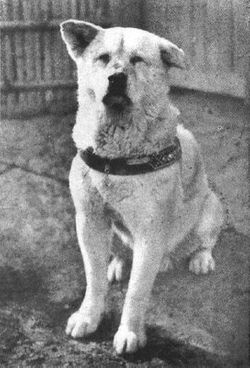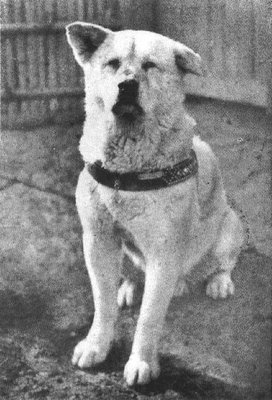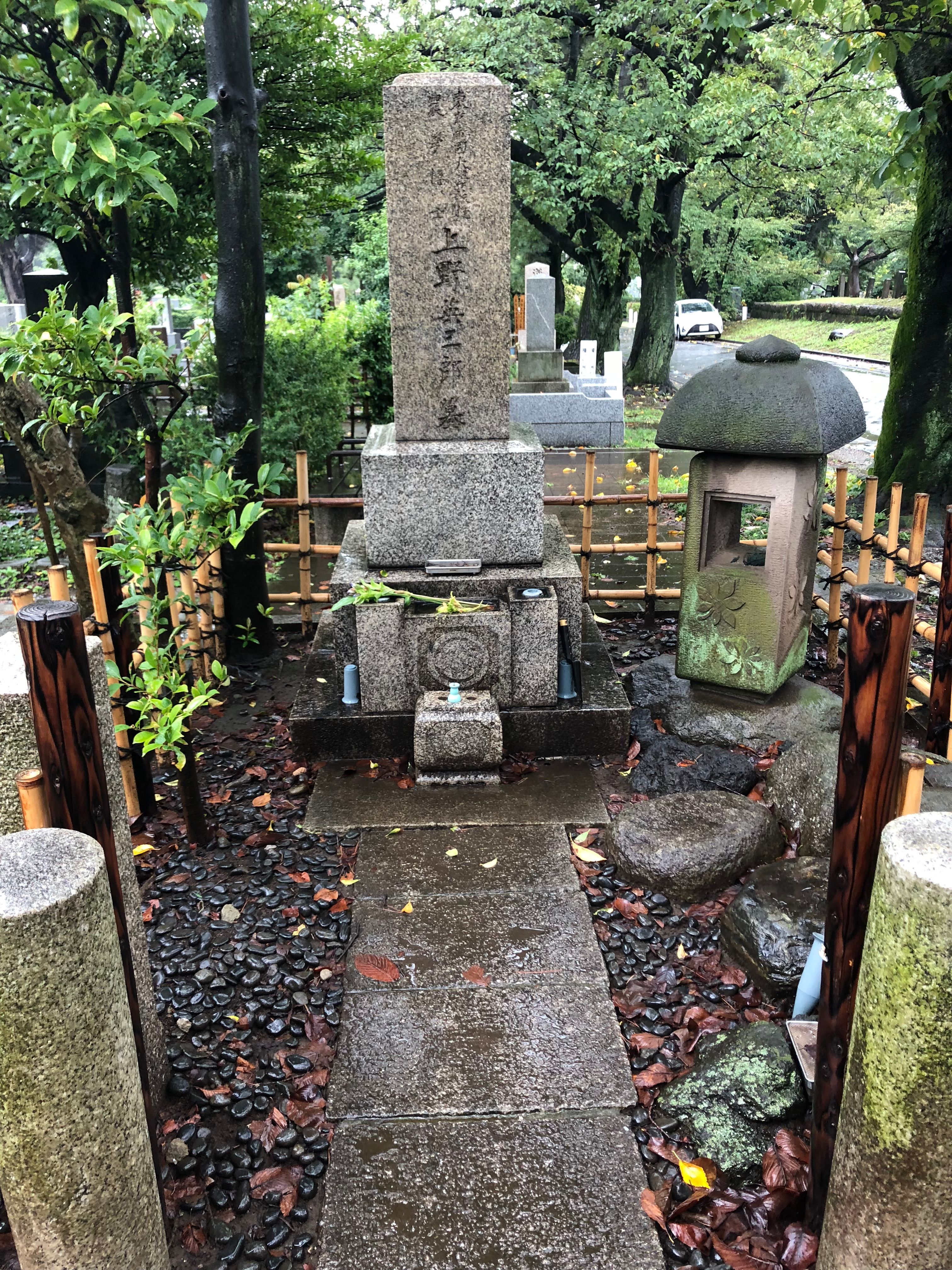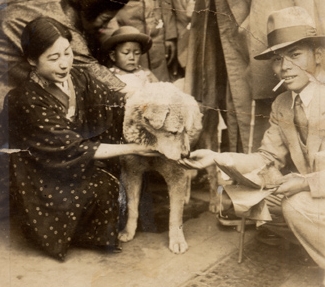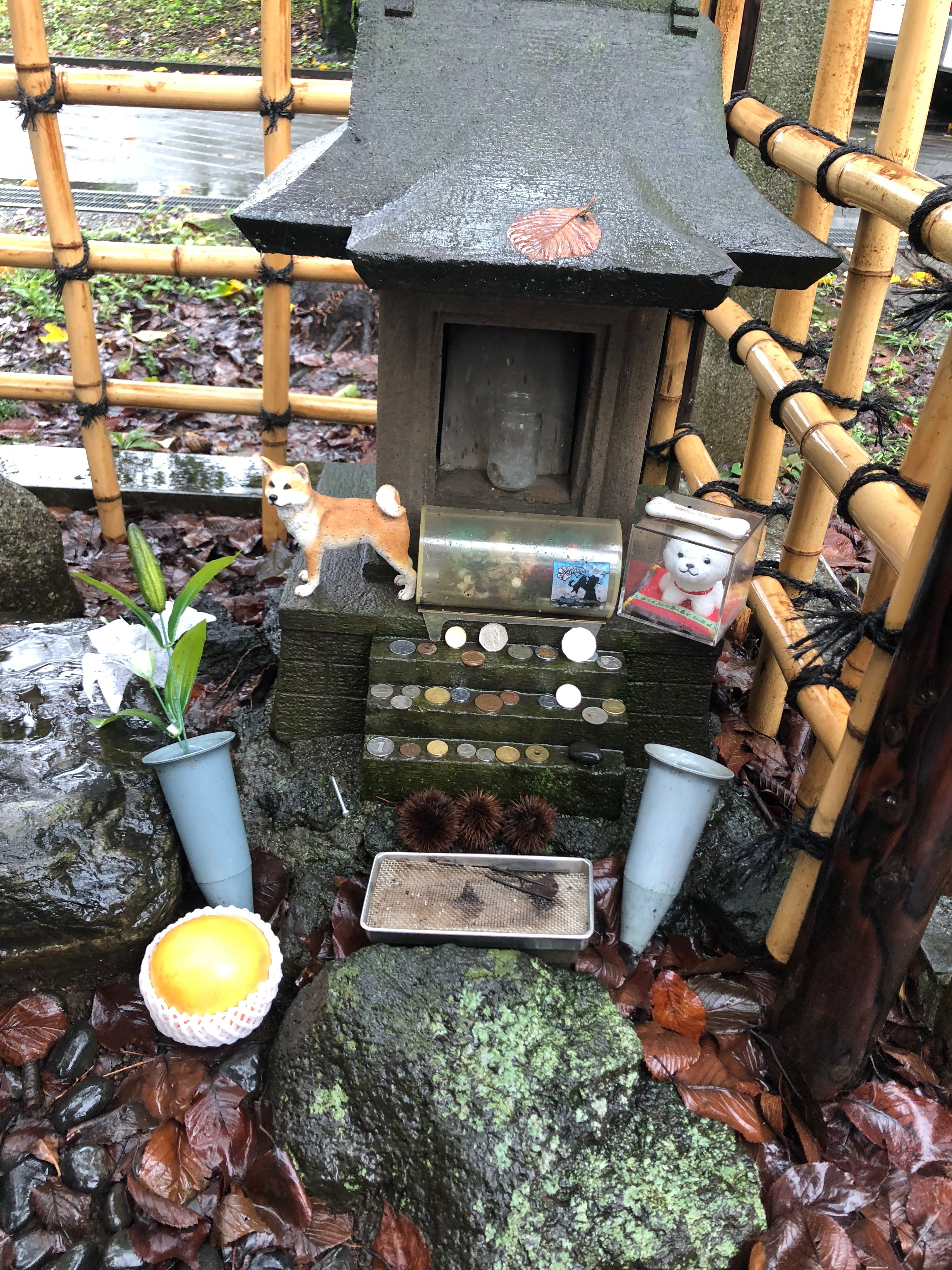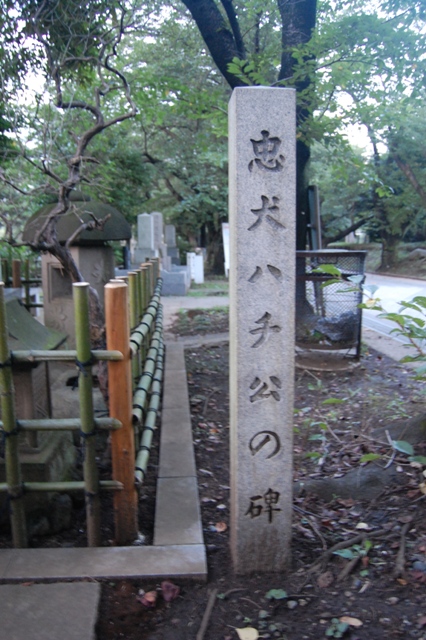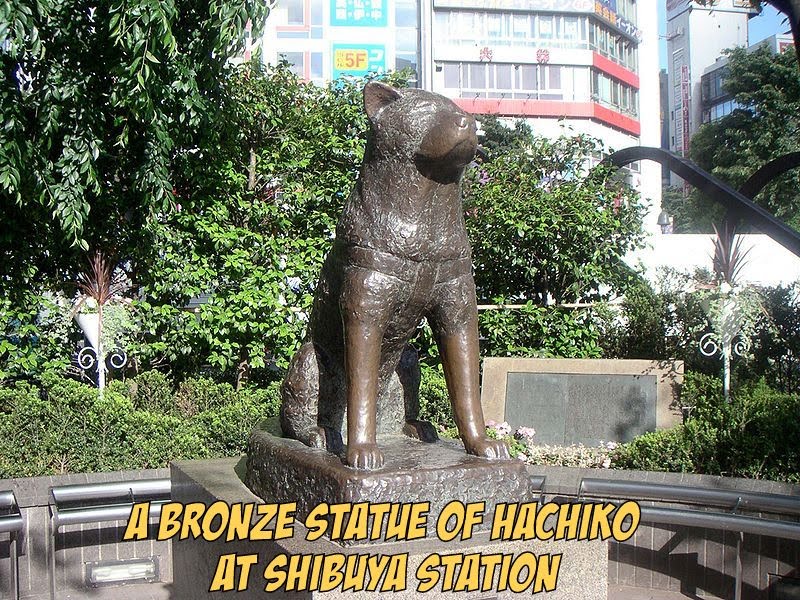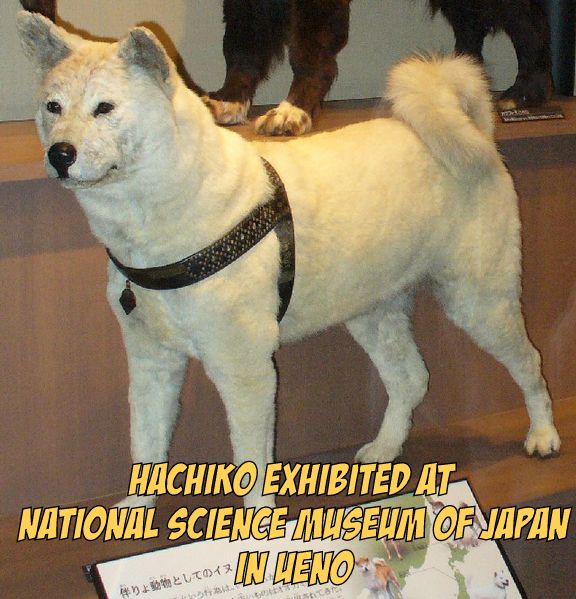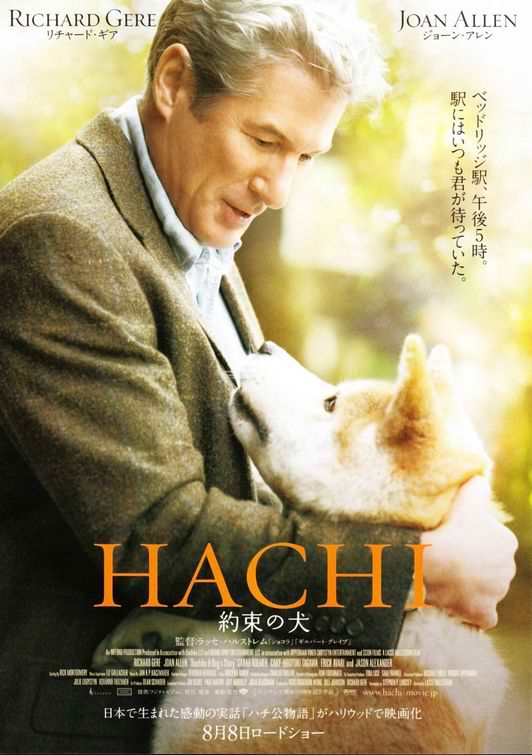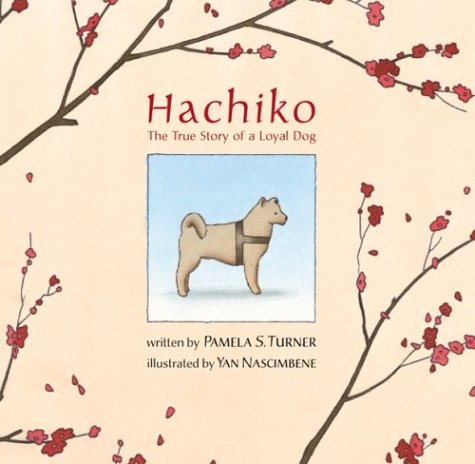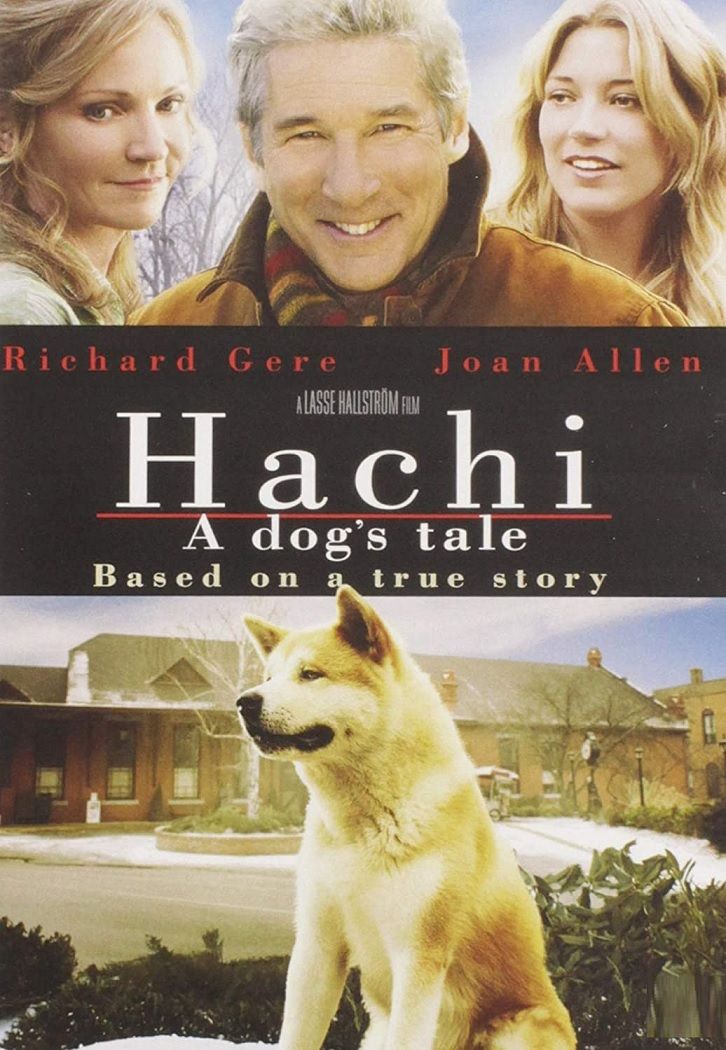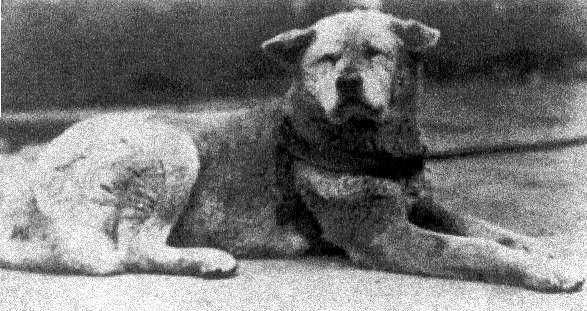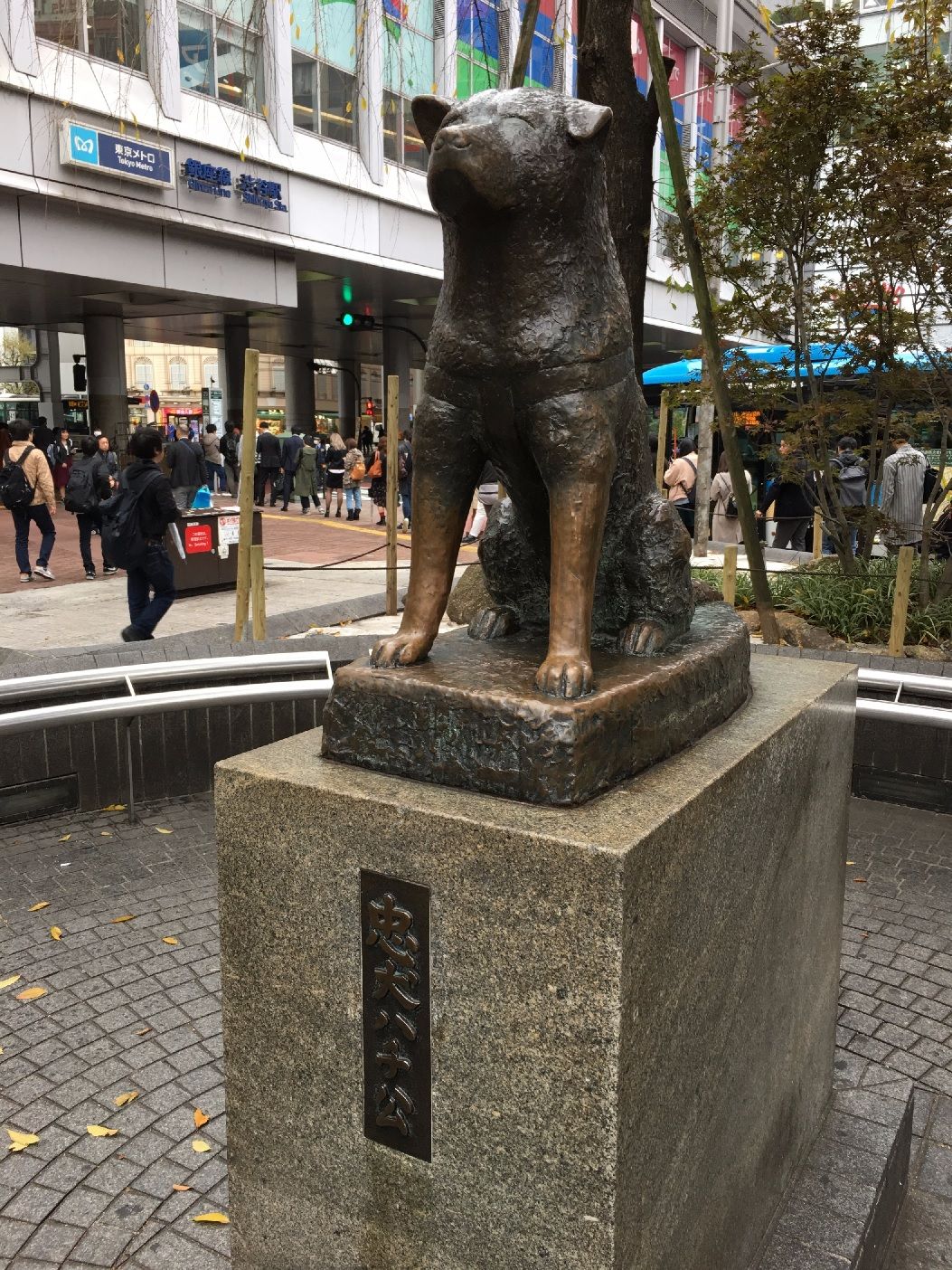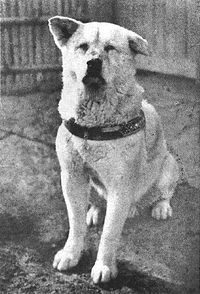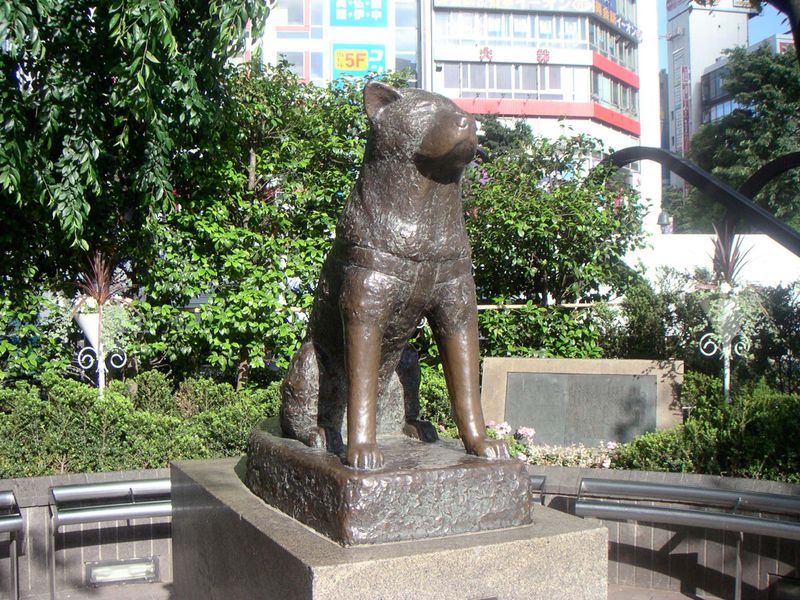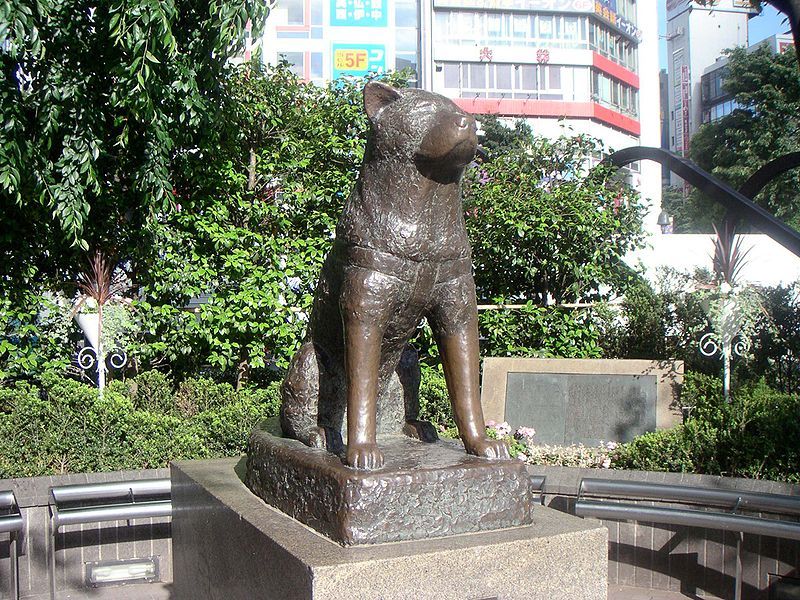A white Akita dog, Hachikō was the faithful pet of owner-care giver Dr. Hidesaburo Ueno, a professor at Tokyo University. The professor's home was in the Shibuya district of Tokyo from where he commuted to the agricultural department in Komaba and to the agricultural experimental station in Nishihara. On May 21, 1925, the professor had not returned because he had suffered a stroke and died at the university. Hachikō was eighteen months old. And the next day and for the next nine years and nine months, Hachikō returned to the station to wait for his beloved owner-care giver before walking home, alone. Nothing nor anyone could discourage Hachikō from maintaining his daily vigil. Hachikō was sent to homes of relatives or friends, but always he escaped to wait at the train station for his owner-care giver, who was never to return. It was not until he followed the professor in death that Hachikō failed to appear at his usual waiting place at the railroad station.
Hachikō's fidelity to the professor was known throughout Japan, owing to a former student of the professor, Hirokichi Saito whose article, "Faithful Old Dog Awaits Return of Master Dead for Seven Years" was published in the national daily Asahi Shimbun (Asahi News), Tokyo's largest newspaper. It would not be overstated that Hirokichi Saito can be attributed for having the initiative and tact in getting the word out for much of the widespread recognition of Hachikō's waiting for the return of his beloved owner-care giver.
Upon the lone dog's death, newspaper stories led to the suggestion that a statue be erected at the station. Contributions were received even from people in the United States and other countries. Today there is a bronze statue of Hachikō, erected at his waiting spot outside the Shibuya railroad station, probably since then the most popular rendezvous point in Shibuya, and pays silent tribute to the Akita breed's faithfulness and loyalty. Statues of Hachiko are also commemorated elsewhere, also in the United States' Rhode Island and New Jersey. Hachikō's fur was preserved after his death, and in realistic form is now on permanent display at the National Science Museum of Japan in Ueno, Tokyo. His flesh was cremated, the ashes rest beside those of his beloved professor … the 1987 Japanese film, Hachikō Monogatari (The Story of Hachikō), depicts the true story of Hachikō, directed by Seijirō Kōyama starring Tatsuya Nakadai, Kaoru Yachigusa, Mako Ishino, and Masumi Harukawa … the 2009 American Hollywood film stars Richard Gere as the professor with Hachikō …
~ ~ ~
In January 1924, a professor at the Japanese Imperial University brought home a two-month old Akita puppy. Dr. Ueno named the pup Hachikō. This beautiful white dog accompanied Dr. Ueno to the Shibuya train station every morning, where Dr. Ueno would say goodbye to Hachikō and head to the university. And every day when Dr. Ueno returned home Hachikō would be waiting for him at the train station and the two would go home together. May 21, 1925 was like any other day for the pair. In the morning, Professor Ueno left Hachikō at Shibuya Station. But when Hachikō returned to Shibuya Station in the evening, his master was nowhere to be found. Though Hachikō waited, Dr. Ueno never showed up. Dr. Ueno had died from a stroke earlier that day. Because Hachikō had only belonged to Dr. Ueno for a little over a year, they probably hoped that the Akita would make a new family with them. But Hachikō didn't care. He ran away from the family and returned to the train station to wait for his master. Every evening Hachikō would return to Shibuya Station and wait for Dr. Ueno to get off the six-o'clock train. The commuters noticed the Akita waiting every day at the station. Some of them had known the pair from when Dr. Ueno was still alive. Months passed. Then years. Hachikō basically lived as a stray. He would call no place home except where Dr. Ueno was, and since Dr. Ueno was nowhere, Hachikō had no home. He lived on the street, fought other dogs, and ate scraps and handouts. A newspaper heard of the dog's story and Hachikō became a Japanese celebrity and everyone who heard of Hachikō's story was touched. People petted him and gave him food. Despite the people's loving intentions, Hachikō got sick with worms and mange, but because so many people admired him he was given treatment by a veterinarian. Hachikō became an old, scarred dog, with one ear up and one ear down, and no longer looked like the purebred Akita that he was. Having waited for his master for almost ten years the old Akita was found in a Shibuya street. It was in March 1935 when Hachikō had died. Many people were saddened by Hachikō's death, but others say that he was finally at peace and could go with his master wherever it is we go when we die. Hachikō's story of loyalty touched the hearts of many people all over the world. In Japan, his statue at Shibuya Station is still a popular meeting place. There every year, a solemn ceremony is held April 8 in remembrance. The place where Hachiko waited is marked with bronze pawprints. • In 1961 Yaeko Sakano Ueno, Ueno's unmarried partner, died, and in 2016 Ueno and Sakano family members made possible Hachikō's Family Reunion at a ceremony with some of Yaeko Sakano's ashes buried with Ueno & Hachikō, her name & death inscribed on Ueno's tombstone, thus reuniting Hachikō with his human family. • In the United States author Mayumi Itoh is considered the "official biographer" of Hachikō, and is a former Professor of Political Science at the University of Nevada, Las Vegas, and previously taught at Princeton University and Queens College, City University of New York. She currently teaches haiku writing at Princeton University. Mayumi is best known to Hachi friends for, Hachikō: Solving Twenty Mysteries about the Most Famous Dog in Japan. Mayumi is the author of a dozen books on politics, including Japanese Wartime Zoo Policy, and Animals and the Fukushima Nuclear Disaster. In addition, Mayumi has written 22 haiku collections, including Haikus for Hiroshige's One Hundred Famous Scenes of Edo.
the story of Hachikō remains both inspiring and devastating the world over after nearly a century … at this writing he is not in Guinness tho' it is not unusual in the same sentence to see, Guinness World Book of Records and Hachikō …
Hachikō (November 10, 1923 – March 8, 1935), an Akita dog born on a farm near the city of Ōdate, Akita Prefecture, Japan. He is remembered for his remarkable loyalty to his owner-caregiver even after his owner's death, for nearly ten years, until his own, when the waiting ended …
~ ~ ~
He died at the age of 11 and he waited 9 years at a train station for his dead owner to return
A white Akita dog, Hachikō was the faithful pet of owner-care giver Dr. Hidesaburo Ueno, a professor at Tokyo University. The professor's home was in the Shibuya district of Tokyo from where he commuted to the agricultural department in Komaba and to the agricultural experimental station in Nishihara. On May 21, 1925, the professor had not returned because he had suffered a stroke and died at the university. Hachikō was eighteen months old. And the next day and for the next nine years and nine months, Hachikō returned to the station to wait for his beloved owner-care giver before walking home, alone. Nothing nor anyone could discourage Hachikō from maintaining his daily vigil. Hachikō was sent to homes of relatives or friends, but always he escaped to wait at the train station for his owner-care giver, who was never to return. It was not until he followed the professor in death that Hachikō failed to appear at his usual waiting place at the railroad station.
Hachikō's fidelity to the professor was known throughout Japan, owing to a former student of the professor, Hirokichi Saito whose article, "Faithful Old Dog Awaits Return of Master Dead for Seven Years" was published in the national daily Asahi Shimbun (Asahi News), Tokyo's largest newspaper. It would not be overstated that Hirokichi Saito can be attributed for having the initiative and tact in getting the word out for much of the widespread recognition of Hachikō's waiting for the return of his beloved owner-care giver.
Upon the lone dog's death, newspaper stories led to the suggestion that a statue be erected at the station. Contributions were received even from people in the United States and other countries. Today there is a bronze statue of Hachikō, erected at his waiting spot outside the Shibuya railroad station, probably since then the most popular rendezvous point in Shibuya, and pays silent tribute to the Akita breed's faithfulness and loyalty. Statues of Hachiko are also commemorated elsewhere, also in the United States' Rhode Island and New Jersey. Hachikō's fur was preserved after his death, and in realistic form is now on permanent display at the National Science Museum of Japan in Ueno, Tokyo. His flesh was cremated, the ashes rest beside those of his beloved professor … the 1987 Japanese film, Hachikō Monogatari (The Story of Hachikō), depicts the true story of Hachikō, directed by Seijirō Kōyama starring Tatsuya Nakadai, Kaoru Yachigusa, Mako Ishino, and Masumi Harukawa … the 2009 American Hollywood film stars Richard Gere as the professor with Hachikō …
~ ~ ~
In January 1924, a professor at the Japanese Imperial University brought home a two-month old Akita puppy. Dr. Ueno named the pup Hachikō. This beautiful white dog accompanied Dr. Ueno to the Shibuya train station every morning, where Dr. Ueno would say goodbye to Hachikō and head to the university. And every day when Dr. Ueno returned home Hachikō would be waiting for him at the train station and the two would go home together. May 21, 1925 was like any other day for the pair. In the morning, Professor Ueno left Hachikō at Shibuya Station. But when Hachikō returned to Shibuya Station in the evening, his master was nowhere to be found. Though Hachikō waited, Dr. Ueno never showed up. Dr. Ueno had died from a stroke earlier that day. Because Hachikō had only belonged to Dr. Ueno for a little over a year, they probably hoped that the Akita would make a new family with them. But Hachikō didn't care. He ran away from the family and returned to the train station to wait for his master. Every evening Hachikō would return to Shibuya Station and wait for Dr. Ueno to get off the six-o'clock train. The commuters noticed the Akita waiting every day at the station. Some of them had known the pair from when Dr. Ueno was still alive. Months passed. Then years. Hachikō basically lived as a stray. He would call no place home except where Dr. Ueno was, and since Dr. Ueno was nowhere, Hachikō had no home. He lived on the street, fought other dogs, and ate scraps and handouts. A newspaper heard of the dog's story and Hachikō became a Japanese celebrity and everyone who heard of Hachikō's story was touched. People petted him and gave him food. Despite the people's loving intentions, Hachikō got sick with worms and mange, but because so many people admired him he was given treatment by a veterinarian. Hachikō became an old, scarred dog, with one ear up and one ear down, and no longer looked like the purebred Akita that he was. Having waited for his master for almost ten years the old Akita was found in a Shibuya street. It was in March 1935 when Hachikō had died. Many people were saddened by Hachikō's death, but others say that he was finally at peace and could go with his master wherever it is we go when we die. Hachikō's story of loyalty touched the hearts of many people all over the world. In Japan, his statue at Shibuya Station is still a popular meeting place. There every year, a solemn ceremony is held April 8 in remembrance. The place where Hachiko waited is marked with bronze pawprints. • In 1961 Yaeko Sakano Ueno, Ueno's unmarried partner, died, and in 2016 Ueno and Sakano family members made possible Hachikō's Family Reunion at a ceremony with some of Yaeko Sakano's ashes buried with Ueno & Hachikō, her name & death inscribed on Ueno's tombstone, thus reuniting Hachikō with his human family. • In the United States author Mayumi Itoh is considered the "official biographer" of Hachikō, and is a former Professor of Political Science at the University of Nevada, Las Vegas, and previously taught at Princeton University and Queens College, City University of New York. She currently teaches haiku writing at Princeton University. Mayumi is best known to Hachi friends for, Hachikō: Solving Twenty Mysteries about the Most Famous Dog in Japan. Mayumi is the author of a dozen books on politics, including Japanese Wartime Zoo Policy, and Animals and the Fukushima Nuclear Disaster. In addition, Mayumi has written 22 haiku collections, including Haikus for Hiroshige's One Hundred Famous Scenes of Edo.
the story of Hachikō remains both inspiring and devastating the world over after nearly a century … at this writing he is not in Guinness tho' it is not unusual in the same sentence to see, Guinness World Book of Records and Hachikō …
Hachikō (November 10, 1923 – March 8, 1935), an Akita dog born on a farm near the city of Ōdate, Akita Prefecture, Japan. He is remembered for his remarkable loyalty to his owner-caregiver even after his owner's death, for nearly ten years, until his own, when the waiting ended …
~ ~ ~
He died at the age of 11 and he waited 9 years at a train station for his dead owner to return
Bio by: Warrick L. Barrett
